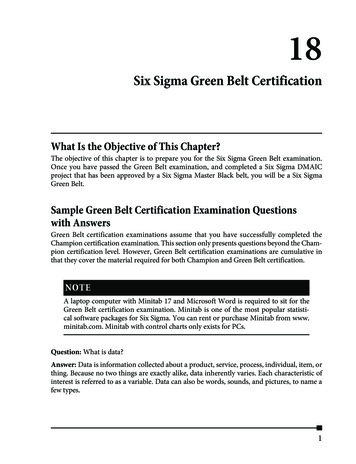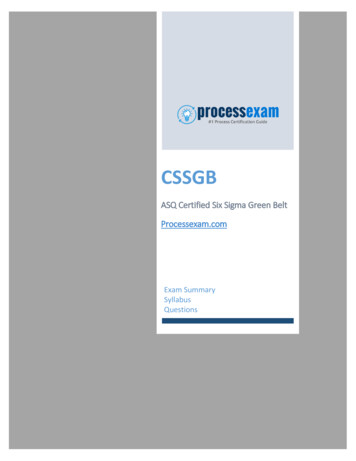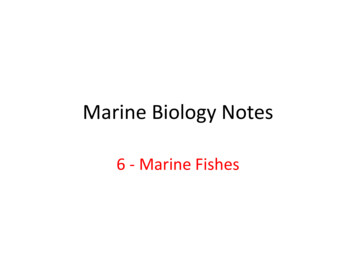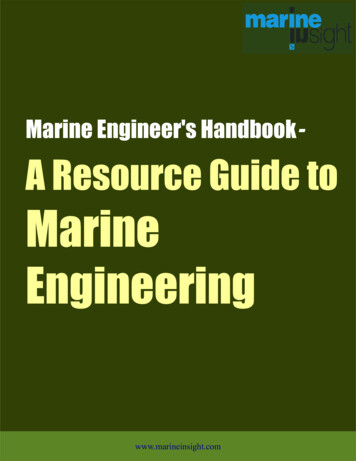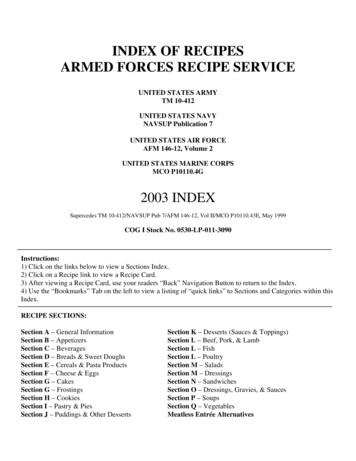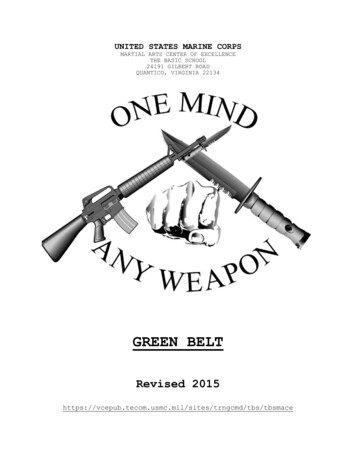
Transcription
UNITED STATES MARINE CORPSMARTIAL ARTS CENTER OF EXCELLENCETHE BASIC SCHOOL24191 GILBERT ROADQUANTICO, VIRGINIA 22134GREEN BELTRevised s/tbsmace
TABLE OF CONTENTSLesson IDLesson TitlePage #MCCS-GREEN-2021BAYONET 4THROWS.19MCCS-GREEN-2025COUNTERS TO STRIKES.27MCCS-GREEN-2026LOWER BODY STRIKES.35MCCS-GREEN-2028UNARMED MANIPULATIONS.41MCCS-GREEN-2029KNIFE TECHNIQUES.51MCCS-GREEN-2031WEAPONS OF OPPORTUNITY.59MCCS-GREEN-2032GROUND FIGHTING.67MCCS-GREEN-2033ANATOMY AND PHYSIOLOGY.75MCCS-GREEN-2034MARTIAL CULTURE STUDY: THE SPARTANS.85MCCS-GREEN-2035FREE SPARRING.93GUIDED DISCUSSION 1:COMBAT STRESS.99GUIDED DISCUSSION 2:SPOUSAL ABUSE.111GUIDED DISCUSSION 3:86,400 SECONDS.117GUIDED DISCUSSION 4:FEAR.127GUIDED DISCUSSION 5:ALCOHOL ABUSE.1371
2
MCCS-GREEN-2021UNITED STATES MARINE CORPSMARTIAL ARTS CENTER OF EXCELLENCETHE BASIC SCHOOL24191 GILBERT ROADQUANTICO, VIRGINIA 22134LESSON PLANBAYONET TECHNIQUESMCCS-GREEN-2021GREEN BELTAPPROVED BY:LtCol (Ret) Shusko, J. C.3DATE: 07/10/2015
MCCS-GREEN-2021UNITED STATES MARINE CORPSMARTIAL ARTS CENTER OF EXCELLENCETHE BASIC SCHOOL24191 GILBERT ROADQUANTICO, VIRGINIA 22134INSTRUCTOR PREPARATION GUIDELESSON TITLE:Bayonet TechniquesLESSON DESIGNATOR:MCCS-GREEN-2021TOTAL LESSON TIME:2 hoursREFERENCES:MCO 1500.59NAVMC 3500.41MCRP 3-02BPERSONNEL REQUIRED:One instructor and assistantsFACILITIES:Soft footed training areaREVIEW COURSE MATERIALS: Review Lesson PlanADD PERSONALIZATION: Personalize the lesson by adding subject matter detail,personal experiences, examples, and questions.MATERIALS/EQUIPMENT: Rifle/Training Rifle Bayonet Trainer Wooden Bayonet Trainer Flak Jacket Helmet MouthpieceSETUP AND PLANNING: Reserve Training Area Conduct Rehearsals4
MCCS-GREEN-2021INTRODUCTION(3 MIN)1. GAIN ATTENTION. Our Corps was born in the fire and blood ofrevolution and has been forged and tempered in over 230 years ofconflict and defense of the Nation. The fighting that took placein battles such as Bloody Ridge, Bairoko and Okinawa was “CloseIn” fighting; fighting consisting of grenades, firing roundswhile closing, bayoneting and even knife fighting. The successof those who went before us was not achieved without the fog ofwar. We should understand these stresses and be prepared tohandle them.2. OVERVIEW. Good morning, my name is .will cover bayonet techniques and the fog of war.3.This lessonPOSITIONSINSTRUCTOR NOTE: Assign demonstration and practice positions.Ensure students have enough space, and can see and hear theinstructor.4.SAFETY.To prevent injury, ensure the following:a.Start slowly and increase speed with proficiency.b.Never execute techniques at full force or full speed.c.Training will be conducted in three stages.(1) Marines will execute techniques in the air.(2) Marines will practice strikes on a pad or dummy.(3) Marines will practice during free sparring.d.Before training with firearms, unload and show clear.e.When handling firearms, the weapons safety rules apply.(1) Treat every weapon as if it were loaded.(2) Never point a weapon at anything you do not intend toshoot.(3) Keep your finger straight and off the trigger untilyou are ready to fire.(4) Keep your weapon on “safe” until you intend to fire.f. Conduct all practical application utilizing approvedtraining gear.5
MCCS-GREEN-2021TRANSITION. Now that you know what will be covered are there anyquestions? Let’s discuss the purpose of bayonet techniques.BODY1.(45 MIN)EXPLAINa. Purpose. The purpose of bayonet techniques is to disableor kill an aggressor.b. Principles. The principles for bayonet techniques aremindset, grip, stance, and movement.(1) Mindset. When engaged, your mindset is a factor ofsuccess or failure. Mindset is the "mental trigger" during adefining moment that enables you to commit to an attack. Youmust have the superior mindset against the aggressor to succeed.(2) Grip. It is possible to execute these bayonettechniques while gripping the buttstock of the weapon, but thestress is on being able to execute them from the pistol grip.These are lethal, offensive techniques that can be used inconjunction with assault fire movement.(a) Grab the pistol grip with your right hand. Keepyour trigger finger off the trigger and included it in the grip.(b) With the left hand, grab the hand guards of therifle under-handed.(c) Lock the buttstock of the rifle against the hipwith the right forearm.(d) Keep movements of the bayonet blade within a box,shoulder width across from your neck down to your waistline.Always keep the bayonet end of the rifle oriented toward theaggressor.(3) Stance. All movement begins and ends with themodified basic warrior stance. Create a smaller silhouette andlower center of gravity by lowering your body at the knees andcreate “eye-muzzle-target” toward the aggressor.(4) Movement. Movement is used to get from one place toanother when the threat of contact is imminent. Use a controlledand steady combat glide to avoid tripping while moving toward theaggressor.c. Fundamentals. The fundamentals for bayonet techniquesare approach, close, and entry.6
MCCS-GREEN-2021(1) Approach. Approaching is used when you have locatedthe aggressor. While maintaining a combat glide, move toward theaggressor until you are within 5 to 10 feet. The bayonet muststay locked on the aggressor.(2) Close. As you reach the critical distance of 5 to 10feet, you will use a burst of speed to close the final distancewith the aggressor. Increase your speed by quickening your stepswithout changing your stride length or standing upright. Thiswill cause the aggressor to hesitate and give you thepsychological and tactical advantage.(3) Entry. The entry is made to get inside theaggressor’s defense to conduct a lethal attack. The movement canbe a step forward or to an oblique to get within range.(a) Target Areas. The primary target areas of thebody are the aggressors throat, groin, or face. The aggressor’storso can be another target area if it is not protected by bodyarmor.(b) Striking Surface. Thrusts will use the point ofthe bayonet and slashes will use the cutting edge of the bayonet.Buttstrokes will use the toe of the buttstock off the rifle andsmashes will use the butt of the rifle.TRANSITION: We have covered the purpose, principles, andfundamentals, are there any questions? I will now demonstratethe first technique.2.DEMONSTRATEINSTRUCTOR NOTE: Demonstrate only one technique at a time.Do not explain the steps or open the class for questions.INTERIM TRANSITION:3.Go to practice position one.IMITATEa.Disrupt And Thrust While Closing With A Moving Aggressor.(1) Assume the modified basic warrior stanceapproximately 30 to 40 feet away from the aggressor.(2) You and the aggressor will approach each other bymoving at a fast walk, using your legs to absorb the impact ofyour steps. Ensure the bayonet stays locked on the aggressor andit is not bouncing as you move.7
MCCS-GREEN-2021(3) As you reach the critical distance of 5 to 10 feetfrom the aggressor you will use a burst of speed to close thefinal distance in a controlled aggressive manner.FAULT CHECK: Allow students to practice approach and closewith a moving apponent until they become proficient.(4) While closing, disrupt the aggressor’s weapon byrotating your body slightly to the right, moving their bayonetslightly off line. You only need to redirect the aggressor’sweapon a couple of inches to have the weapon miss your body.This will give your blade a clear path to your primary target.FAULT CHECK: The disrupt is performed concurrent with thethrust. It is not an independent movement.(5) Enter by stepping forward and thrusting the blade ofthe weapon directly into the target. Continue to drive throughthe aggressor.(6) Retract to the modified basic warrior stance, scanthe area for additional threats, and prepare for follow onattacks.b. Buttstroke Offline With a Stationary Aggressor. Thistechnique is used if your thrust is interrupted by theaggressor’s weapon. Interruption is defined as your weapon beingentangled or knocked offline.(1) Assume the modified basic warrior stanceapproximately 20 to 30 feet away from the aggressor.(2) Execute your approach and close on the aggressor.(3) While closing, execute a straight thrust. Thisthrust is interrupted by the aggressor’s weapon (such as frontsight assemblies catching on each other).(4) Once your weapon has been interrupted, move forwardright while executing a horizontal or vertical buttstroke.FAULT CHECK: Ensure Marines step at a 45 degree angle to theright with their right foot.(5) Step forward with your left foot executing a slash,followed by a straight thrust.8
MCCS-GREEN-2021(6) Retract to the modified basic warrior stance, scanthe area for additional threats, and prepare for follow onattacks.4.PRACTICEINSTRUCTOR NOTE: Fault check student proficiency and safety.TRANSITION: We have learned bayonet techniques, are there anyquestions? We must also understand the elements of the fog ofwar.5.TIE-IN (FOG OF WAR). What do we mean by the "fog of war?"This expression describes both the literal fog created by thedust, smoke, and debris of the battlefield, and more importantlythe mental fog of confusion and uncertainty created by lack ofknowledge of the enemy, the chaotic noise, mental and physicalfatigue, and fear.a. What significance does this stress have to the individualMarine? As with the condition of risk and fear, the individualmust be able to function in an environment that may appearconfusing and chaotic. By focusing his/her attention on the taskat hand, on working with fellow Marines, and on the leader'scommands, the individual will overcome this stress.Additionally, good intelligence can help to clear some of the fogof war.b. What significance does the "fog of war" have to you, theleader? The leader must be aware of the problems caused by theconfusion of battle. Tired as he or she may be, they mustrealize that their Marines are equally tired. They must have yetadditional strength to see that commands are obeyed and essentialtasks accomplished. They must help cut through the fog andconfusion of combat by keeping orders clear, simple, audible, andunderstood, ensuring that the unit continues to function as ateam. Most of all, they must make certain that their Marinesnever become confused about their own unit's ability to fight.Leaders must ensure their units are a cohesive force on thebattlefield regardless of the chaos and confusion.c. The above fog of war can be mitigated or overcome by thefollowing training yourself and your Marines constantly,realistically, tough and as a team. This applies both before andduring combat. Ensure you have a unit that is cohesive,disciplined, and has a high state of morale. This comes onlyfrom good training and positive leadership.9
MCCS-GREEN-2021INSTRUCTOR NOTE: Instructors may enhance this tie-in withadditional material in Appendix A, Guided Discussion 1.TRANSITION:questions?We have discussed the fog of war, are there anySUMMARY(10 MIN)During this period of instruction we have covered bayonettechniques and the fog of war. I am now confident you will beable to use these techniques to kill the enemy if necessary.INSTRUCTOR NOTE: Provide follow-on instructions.10
MCCS-GREEN-2023UNITED STATES MARINE CORPSMARTIAL ARTS CENTER OF EXCELLENCETHE BASIC SCHOOL24191 GILBERT ROADQUANTICO, VIRGINIA 22134LESSON PLANCHOKESMCCS-GREEN-2023GREEN BELTAPPROVED BY:LtCol (Ret) Shusko, J. C.11DATE: 07/21/2015
MCCS-GREEN-2023UNITED STATES MARINE CORPSMARTIAL ARTS CENTER OF EXCELLENCETHE BASIC SCHOOL24191 GILBERT ROADQUANTICO, VIRGINIA 22134INSTRUCTOR PREPARATION GUIDELESSON TITLE:ChokesLESSON DESIGNATOR:MCCS-GREEN-2023TOTAL LESSON TIME:45 minutesREFERENCES:MCO 1500.59NAVMC 3500.41MCRP 3-02BPERSONNEL REQUIRED:One instructor per twelvestudents, assistants as neededFACILITIES:Soft footed training areaREVIEW COURSE MATERIALS: Review Lesson PlanADD PERSONALIZATION: Personalize the lesson by adding subject matter detail,personal experiences, examples, and questions.MATERIALS/EQUIPMENT: MouthpieceSETUP AND PLANNING: Reserve Training Area Conduct Rehearsals12
MCCS-GREEN-2023INTRODUCTION(5 MIN)1. GAIN ATTENTION. When performed correctly, a choke can renderan aggressor unconscious in as little as eight to thirteenseconds, regardless of size or gender. However, to be effective,you must fully understand how to apply the techniques. AllMarines must know when would be the right or wrong time to usethese techniques.2. OVERVIEW. Good morning, my name is .will cover chokes and right versus wrong.3.This lessonPOSITIONSINSTRUCTOR NOTE: Assign demonstration and practice positions.Ensure students have enough space, and can see and hear theinstructor.4.SAFETY.To prevent injury, ensure the following:a.Start slowly and increase speed with proficiency.b.Never execute techniques at full force or full speed.c.Techniques will be performed on a soft-footed area.d. Apply slow, steady pressure until the aggressor taps out.Aggressor will tap out when they become uncomfortable. They maytap the deck, tap themselves, tap the Marine, or verbally say“tap-tap-tap.” The Marine must immediately release the pressurewhen the aggressor taps out.e. Never hold a choke for more than five seconds intraining. The aggressor should never become light headed.f.Do not apply pressure to the trachea during training.TRANSITION. Now that you know what will be covered are there anyquestions? Let’s discuss the purpose of chokes.BODY1.(30 MIN)EXPLAINa. Purpose. The purpose of chokes is to render an aggressorunconscious or gain control of the situation using less thanlethal force.13
MCCS-GREEN-2023b. Principles. The principles for chokes are the two typesof chokes: blood chokes and air chokes. This choke will alsoapply the fundamentals of counters to strikes.(1) Blood Chokes. A blood choke is performed on thecarotid artery, which carries oxygen-enriched blood from theheart to the brain. The carotid artery is located on both sidesof the neck. When executed properly, a blood choke takes 8 to 13seconds to render the aggressor unconscious. The blood choke ispreferred because it can end the fight more quickly.(2) Air Chokes. An air choke is performed on thewindpipe or trachea, cutting off the air to the lungs and heart.When executed properly, an air choke takes 2 to 3 minutes torender the aggressor unconscious. The air choke is notrecommended because of the length of time it takes to end thefight. Air chokes are not taught in MCMAP.(3) Counters to Strikes. When executing the side chokeyou will be countering the aggressor’s strike. You must move outof the way of the punch, block the attacking arm, and follow onwith the choke.c. Fundamentals. The fundamental for chokes is control.Control the aggressor’s center of gravity and weight distributionto allow you to keep them in a vulnerable position long enoughfor the choke to be effective.TRANSITION: We have covered the purpose, principles, andfundamentals, are there any questions? I will now demonstratethe first technique.2.DEMONSTRATEINSTRUCTOR NOTE: Demonstrate only one technique at a time.Do not explain the steps or open the class for questions.INTERIM TRANSITION:3.Go to practice position one.IMITATEa. Side Choke. The side choke is effective when deflectingthe aggressor’s punch when you are facing each other.(1) Begin facing the aggressor in the basic warriorstance.(2) The aggressor executes a rear hand punch. Execute aforward left angle of movement and block the aggressor’s arminboard with your left forearm.14
MCCS-GREEN-2023(3) Bring your right arm underneath the aggressor's rightarm and place your radius bone across the aggressor’s leftcarotid artery. Your right palm should be face down with fingersextended and your thumb pointing toward you.(4) Reach around the back of the aggressor’s neck withyour left hand and clasp your hands together, left hand palm up.The aggressor’s right arm should be over your right shoulder.(5) Pull the aggressor toward your chest, exertingpressure on his left carotid artery with your right radius bone.At the same time, push up with your shoulder and head against theaggressor’s triceps, driving his right shoulder into his rightcarotid artery.(6) Your shoulder and head should be placed high on thetriceps close to the armpit to drive the shoulder effectively.Ensure pressure is applied to both sides of the neck and not thetrachea or windpipe.4.PRACTICEINSTRUCTOR NOTE: Fault check student proficiency and safety.TRANSITION: We have learned chokes, are there any questions?Every Marine must also understand right versus wrong.5. TIE-IN (RIGHT VERSUS WRONG). Marines should set the examplein every aspect of their lives and constantly hold themselves tothe highest personal standards, whether it is as a leader or asfollower. If a Marine continuously sets the example, he or shewill be successful in all aspects of life. If a Marinereligiously pursues attainment of all of the leadership traits,he or she will unequivocally set a good example.a. Sometimes doing what is right is not the easiest path tofollow. Certain situations arise in which the best course ofaction cannot be clearly decided as being the right or wrongthing to do. A good example is the well-known dilemma ofstealing a loaf of bread to feed a hungry family. Your responseto these dilemmas will depend upon your upbringing and exposureto morals and ethics. What may be right and justified in oneculture or sub-culture may be inappropriate or illegal inanother. It is in this fine distinction that many Marines findthemselves confused.b. Consider the young Marine who was brought up in the innercity with regular exposure to drugs and violence. Afteraccession into the Marine Corps, this individual gets caughtsmoking marijuana and is repeatedly disciplined for fighting.15
MCCS-GREEN-2023While drugs and violence against peers may have been the norm inthe inner city, it was emphasized in training that it is illegal,and has no place in the Marine Corps. In such cases, Marinesneed to know those common cultural norms of society as a wholeand the Marine Corps regulations override any pre-existing subcultural norms. This is not to say all crime in the Marine Corpsis attributable to a lack of moral and ethical training, butsimply that with specific training, the Marine will know aparticular action is right or wrong.c. The basic Marine Corps definition of integrity, “Marinesdo not lie, cheat or steal, nor tolerate those who do,” must bethe foundation of every Marine’s professional ethics. Whenofficers and NCO’s deviate from the standards of conduct, itmakes correcting other Marines nearly impossible. In a letter toProfessor Carl Montor, Admiral Arleigh Burke summed up theimportance of integrity:First you find yourself overlooking small infractionsthat you would have corrected on the spot in the past.Soon you are a participant in these infractions.“After all,” you say, “Everybody’s doing it.” All toosoon you find yourself trapped:You no longer canstand on a favorite principle because you have strayedfrom it. Finding no way out, you begin to rationalize,and then you are hooked.The important fact is, themen [and women] who travel the path outlined above havemisused the very basic quality and characteristicexpected of a professional military man [or woman], orany other professional man [or woman] for that matter:They have compromised their integrity.d. Perhaps one of the most difficult tests of integrity ispeer pressure. Everyone has been in a situation where “everyone”is doing something wrong, and the pressure to join in is great.One may think, “If I don’t join in, then I will lose respectamong my peers, or not gain it.” This is untrue in theprofessional environment. We as Marines, have the moralobligation to do what is right. This means not surrendering topeer pressure when it may involve illegal or immoral decisions.Every Marine starts out his or her career with unblemishedintegrity, and it is up to the individual to either maintain ortarnish that integrity. Once one’s integrity has beencompromised, it is very difficult to regain it. Doing the rightthing will not always make you the most popular Marine in thesquad bay, but it will give you a clean conscience and commandthe respect of others. It is obvious that down the road respectis far more important than winning any popularity contest. Inshort, integrity and “doing the right thing” go hand in hand.e. It is easy to sit back and say you would do the rightthing by keeping a friend from driving drunk, or turning a peer16
MCCS-GREEN-2023over to the authorities for committing a violent crime. But whatabout doing the right thing when no one is in immediate or evenremote jeopardy of being hurt? Surely, doing the wrong thing bynot turning someone in for cheating on a test is better thanostracizing yourself from your group of friends, isn’t it? Notin the Corps! Even fulfilling a promise is no justification formoral wrong doing.f. Again, we are Marines and are subject to a stronger setof morals and ethics than most civilian organizations. When aMarine deviates from this moral path it is the responsibility ofhis fellow Marines to help him back onto the path, or riskhimself becoming no different from the cheater. Furthermore,whether we realize it or not, most rules have a purpose. “Thelaw is the last result of human wisdom acting upon humanexperience.” (Samuel Johnson, Miscellanies, I, 223).g. Cheating or bending the rules may not have immediateramifications to the individual, but down the road it couldcreate dire consequences. What about the platoon commander whocheats on a call for fire package, only to find himself in acombat situation in desperate need of supporting arms? How aboutthe young Lance Corporal that lies constantly and gets away withit, and then finds that a lie about a seemingly unimportantsituation gets someone killed or injured. The more we do thewrong thing, the harder it becomes to recognize right from wrong.Conversely, once we bill ourselves as moral and ethical leaders,doing the right thing becomes second nature. This is the pointwhere you will have earned your self-respect and the undyingrespect of your peers.INSTRUCTOR NOTE: Instructors may enhance this tie-in withadditional material in Appendix A, Guided Discussion 2.TRANSITION:questions?We have discussed right versus wrong, are there anySUMMARY(10 MIN)During this period of instruction we have covered chokes andright versus wrong. I am now confident you will be able to usethese techniques to control the situation if necessary.INSTRUCTOR NOTE: Provide follow-on instructions.17
MCCS-GREEN-202318
MCCS-GREEN-2024UNITED STATES MARINE CORPSMARTIAL ARTS CENTER OF EXCELLENCETHE BASIC SCHOOL24191 GILBERT ROADQUANTICO, VIRGINIA 22134LESSON PLANTHROWSMCCS-GREEN-2024GREEN BELTAPPROVED BY:LtCol (Ret) Shusko, J. C.19DATE: 07/21/2015
MCCS-GREEN-2024UNITED STATES MARINE CORPSMARTIAL ARTS CENTER OF EXCELLENCETHE BASIC SCHOOL24191 GILBERT ROADQUANTICO, VIRGINIA 22134INSTRUCTOR PREPARATION GUIDELESSON TITLE:ThrowsLESSON DESIGNATOR:MCCS-GREEN-2024TOTAL LESSON TIME:1 hour 30 minutesREFERENCES:MCO 1500.59NAVMC 3500.41MCRP 3-02BPERSONNEL REQUIRED:One instructor and assistantsFACILITIES:Soft footed training areaREVIEW COURSE MATERIALS: Review Lesson PlanADD PERSONALIZATION: Personalize the lesson by adding subject matter detail,personal experiences, examples, and questions.MATERIALS/EQUIPMENT: MouthpieceSETUP AND PLANNING: Reserve Training Area Conduct Rehearsals20
MCCS-GREEN-2024INTRODUCTION(5 MIN)1. GAIN ATTENTION. Marines will never have the opportunity tochoose their enemies and will need the skills to handle anysituation with any size of aggressor. Throws allow Marines totake any aggressor to the deck in a combat scenario. Many othersskills are also vital to effective combat leadership.2. OVERVIEW. Good morning, my name is .will cover throws and combat leadership.3.This lessonPOSITIONSINSTRUCTOR NOTE: Assign demonstration and practice positions.Ensure students have enough space, and can see and hear theinstructor.4.SAFETY.To prevent injury, ensure the following:a.Start slowly and increase speed with proficiency.b.Never execute techniques at full force or full speed.c.Techniques will be performed on a soft-footed area.d.Students being thrown will execute proper break falls.e. Practice fit-ins when learning throws. To execute a fitin, stop just before throwing the aggressor to the deck.TRANSITION. Now that you know what will be covered are there anyquestions? Let’s discuss the purpose of throws.BODY1.(75 MIN)EXPLAINa. Purpose. The purpose of a throw is to bring an aggressorto the deck to gain the tactical advantage in a fight.b. Principles. The principles for throws are balance,leverage, timing, and body position.(1) Balance. It is important to maintain control of yourbalance to prevent the aggressor from countering the throw.(2) Leverage. You will use the aggressor’s body as alever to increase the power generated for the throw. Leveragewill allow you to throw any aggressor of any size.21
MCCS-GREEN-2024(3) Timing. All throws must be properly timed to attackthe aggressor when they are off-balance and vulnerable.(4) Body Position. You must put your body into aposition that is optimal for the throw. If your position isincorrect, the aggressor can counter the throw.c. Fundamentals. The fundamentals for throws are entry,off-balance, and execution.(1) Entry. The first part of a throw is the entry. Yourentry should be quick and un-telegraphed to prevent the aggressorfrom anticipating your movement and countering your attack. Youalso want to make sure your body positioning is correct inrelation to your aggressor to allow for proper off-balancing andexecution of the throw.(2) Off-Balancing. The second part of a throw is offbalancing. Off-balancing techniques are used to control anaggressor by using his momentum to move or throw him. This aidsin the execution of throws because your aggressor is unable tofight your attack with his full strength when he is off-balanced.(a) Angles of Off-Balancing. There are eight anglesor directions in which an aggressor can be off-balanced: forward,rear, right, left, forward right, forward left, rear right, andrear left. The angles correspond to your perspective, not theaggressor's.(b) Off-Balancing Techniques. An aggressor can beoff-balanced by pushing, pulling, or bumping. Pushing andpulling are performed by grabbing the aggressor with your handsand driving him forcefully to one of the angles of off-balancing.Bumping uses other parts of your body such as your shoulders,hips, and legs to off-balance the aggressor.(c) Momentum. Off-balancing techniques rely on themomentum of the aggressor. For example, if the aggressor ischarging at you, you can pull him to drive him to the deck.Likewise, if the aggressor is pulling on you, you can push him todrive him to the deck. Using momentum is particularly effectivefor Marines who are outsized by the aggressor.INSTRUCTOR NOTE: Students may practice off-balancing.students do not to drive the aggressor to the deck.Ensure(3) Execution. The third and final part of a throw isthe execution. The remaining steps in throwing the aggressor tothe deck are utilized here. Each step before this is just to setup and assist in this final process. Follow through the throw tomaximize power.22
MCCS-GREEN-2024TRANSITION: We have covered the purpose, principles, andfundamentals, are there any questions? I will now demonstratethe first technique.2.DEMONSTRATEINSTRUCTOR NOTE: Demonstrate only one technique at a time.Do not explain the steps or open the class for questions.INTERIM TRANSITION:3.Go to practice position one.IMITATEa. Shoulder Throw. A shoulder throw is particularlyeffective if the aggressor is moving forward or pushing on you.(1) Start facing the aggressor in the basic warriorstance.(2) Grasp the aggressor's right wrist with your left handand step in between his feet with your right foot.(3) Rotate on the ball of your right foot and bring yourleft foot inside the aggressor’s feet. Your heels should betogether and your knees should be bent.(4) At the same time, hook your right arm under the backof the aggressor’s right arm, pinching his triceps with yourbiceps, and pull him in close to you. Your backside and hipshould be lower than and outside your aggressor’s hips and in aposition of leverage.(5) Pull your aggressor’s right arm across your body andslightly lift the aggressor off the deck by bending at the waist,straightening your legs, and rotating your body to your left. Ifthe aggressor cannot be easily lifted, your body position isincorrect.INSTRUCTOR NOTE: Have the students practice fit-ins as manytimes as necessary to become proficient.(6) Drive the aggressor to the deck by forcing him overyour hip and following through with the throw.(7) Rapidly return to the basic warrior stance.4.PRACTICE23
MCCS-GREEN-2024INSTRUCTOR NOTE: Fault check student proficiency and safety.TRANSITION: We have learned throws, are there any questions?Every Marine must also be a proficient combat leader.5. TIE-IN (COMBAT LEADERSHIP). Combat leadership is theapplication of leadership traits and principles under conditionsof extreme stress caused by enemy fire or the high probability ofdirect physical contact with the enemy. It is not necessary tohave experienced combat to understand the essential requi
REFERENCES: MCO 1500.59_ NAVMC 3500.41_ MCRP 3-02B PERSONNEL REQUIRED: One instructor and assistants FACILITIES: Soft footed training area REVIEW COURSE MATERIALS: Review Lesson Plan ADD PERSONALIZATION: Personalize the lesson by adding subject matter detail, personal e
